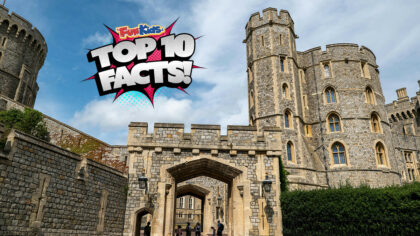Wherever you live, there’s treasure to be discovered!
Not just gold and gems, but stories of buildings, locations and people.
Our heritage is a great wealth… and it’s all around us. Sometimes standing proud in the open air – sometimes hidden behind some bushes.
And to help find it, we’re looking for Heritage Heroes – could you be one?
You can find clues in all sorts of places to find out what happened in your street, neighbourhood and further afield, from famous visitors to historic events.
Here are three tips to help you become a Heritage Hero…

HERITAGE HEROES. AN INSPIRING AUDIO PRODUCTION FOR FUN KIDS. MADE POSSIBLE WITH THE NATIONAL LOTTERY HERITAGE FUND, WITH THANKS TO NATIONAL LOTTERY PLAYERS.
Parks
As towns and cities grew with the industrial revolution, civic pride motivated many to build amazing buildings and places to improve the health and quality of life for its inhabitants.
Not just town halls, libraries and museums, but beautiful parks where everyone could stroll, enjoy music at a bandstand and perhaps play a game of cricket or bowls.
Derby Arboretum is described as Britain’s first public park, opening in 1840. London Zoo opened in 1828 – a few years before Victoria came to the throne.
Derby Arboretum, also informally known as Arboretum Park and The Arboretum, is famous for being Britain’s first public park. It is picturesque with a fine collection of trees. The Arboretum was the first specially designed urban park in Britain. Joseph Strutt commissioned and donated the park for the benefit of citizens of Derby in 1840. The intention was a botanical tree garden for instruction as well as leisure. John Claudius Loudon designed, constructed and planted the gardens, while EB Lamb designed the two Tudor style lodges.
If there’s a public park near you, see if you can find out when it opened. You might find clues on a plaque or in the design of water fountains, public toilets and bandstand. Sometimes parks were opened in the gardens of a grand house – like Holland Park in West London and Cannon Hill Park in Birmingham.
Holland Park is spread across 54 acres of what used to be the grounds of Cope Castle, a large Jacobean mansion hidden in the woods. Sir Walter Cope, who was Chancellor of the Exchequer under King James I, built it in the early 17th century. It was renamed Holland House after the Earl of Holland’s wife Lady Rich inherited the property. Holland House was badly damaged during World War II. One wing was saved and is used as a youth hostel. A section of the front terrace was saved. This is used for the park’s summertime open-air theatre productions and classical concerts.Kyoto Garden was designed and built by an eminent Japanese Garden designer and his team. It was created to celebrate the Japan Festival in London in 1992. This was a co-operative project between the Royal Borough of Kensington and Chelsea and the Kyoto Chamber of Commerce in Japan.
Cannon Hill Park was opened to visitors in 1873, and was designed by TJ Gibson, who also designed Battersea Park in London. Cannon Hill Park is made up of 80 acres of formal parkland and 120 acres of conservation and woodland plantation. Cannon Hill Park was donated to the citizens of Birmingham by Miss Louisa Ryland. She wanted the Park to be a source of healthy recreation for the people of Birmingham, and for them to help protect and preserve the park.
Why don’t you have a go at drawing a map of your local park?
Have a walk around your park. Take photographs, collect bits and bobs to stick to your map – like twigs, leaves and petals, and write down things you see!
Find clues so when you get home, see if you can answer these questions:
- Did you find this place on a map?
- Can you describe how you got to this place from your house using a map?
- Can you describe directions e.g. North, South, East and West?
Now, have a go at drawing your own map of the place you visited today – you can ask an adult to help with the writing.
Use your photos to remind you of the things you saw.
Attach your objects to help make it more exciting!
You can use symbols, street names and different colours to mark out different parts of your local area.
Theatres
Theatre has always been popular.
It had a big boost during the reign of Elizabeth I – just think of Shakespeare and the recreation of The Globe in London.
And it flourished during the Victorian era when it became very popular with the masses, and many new theatres and theatre schools were built.
As well as theatre, the Victorian’s also enjoyed newer forms of entertainment – concert halls to enjoy classical music and music halls for variety acts and popular songs.
The Victorians also enjoyed other things that we still do today – like fairgrounds and circuses.
Cinemas
The cinema, or picture house as they were originally called, were important places for people to find out what was going on as well as have fun.
In the early days, films were silent with musicians providing accompanying music on horseshoe shaped theatre organs.
Companies like Pathe provided news programmes – something which was very important during the world wars.
Many cinemas built in the 1920s and 1930s were in the Art Deco style, with bold lines, shapely curves and colour contrasts that would take the audience to lavish worlds.
Some of these cinemas are still standing and showing films, like the Dreamland Cinema in Margate and Odeon Leicester Square.
Others may have been converted into flats, bingo halls and even places of worship, like the Mecca Kingstanding in Birmingham and Ascot Cinema in Glasgow.
Have a look at your local cinema.
Do you think it was there during the second world war?
Have a look online to see what films and newsreels people might have watched.
Swimming Pools
Whilst it’s always easy to swim if you live by the sea, it’s a little bit harder in towns and cities.
Well, it was until the Victorians developed the idea of public swimming pools, and then there was the development of the Lido – outside swimming pools with diving boards, water chutes, changing rooms and showers. They were built in the 1920s and 30s – just as the benefits of an outdoor swim were being realised. And reached their heyday in the 1930s – at one point more than 160 lidos were open in the UK, many in spectacular art deco surroundings so they’re great to look at as well as swim in. Sadly, as holidays to the coast became cheaper, their appeal waned and many closed as people flocked to the sea.
Some lidos to explore – Lymington Sea Water Baths was built in 1833 and is the oldest lido in the UK – as well as one of the biggest at 110 metres long. Hampton Pool occupies a tranquil spot on the border of Royal Bushy Park. Guildford Lido has been in continuous use since 1933, making it one of the longest-serving lidos in use today – as well as only one of a handful left from the 1930s. It enjoys a position amid four acres of landscaped gardens, making it ideal for poolside picnics and get-togethers.
Find out if there’s a Lido near you – and if its warm enough, why not go for a swim!
Now it’s over to you! Here’s a reminder of things to look for to help you find out about the place where you live.
1 – Take a stroll around your local park and see if you can find clues to when it was designed and how it entertained people. Or visit your library or go online to find a picture from Victorian times.
2 – Check out an old cinema building – remember, it might be a bingo hall or supermarket today! And have a look online to find out what films they might have watched!
3 – And if you fancy a swim why not see if there’s a lido near you. Did you know that lido is the Italian word for beach!
Here are some helpful links that will help you become a Heritage Hero!
Watch old films: www.bfi.org.uk/archive-collections
Explore a history of entertainment: www.ereed.library.utoronto.ca
And about fairground and circus history: www.sheffield.ac.uk/nfca/index
History of markets: www.nationalarchives.gov.uk/help-with-your-research/research-guides/markets-fairs
History of Parks: www.marshalls.co.uk/commercial/blog/parks-and-recreation-the-victorian-way







